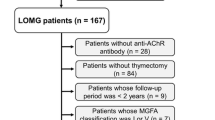Abstract
Randomised and controlled treatment studies of juvenile-onset myasthenia gravis have not been published. We therefore report our retrospective analysis of 79 patients with juvenile-onset myasthenia gravis observed for as long as 30 years. The mean age at onset was 13.7 years and median follow-up 7.7 years. The initial presentation was generalised disease in 90% and ocular disease in the remaining patients. Sixty-five patients (82%) were thymectomised. In 14 of these, treatment consisted of a combination of azathioprine (2–3 mg/kg), corticosteroids (prednisolone up to 60 mg for a maximum duration of 12 months with subsequent tapering) and acetylcholinesterase (AChE) inhibitors, and of azathioprine and AChE inhibitors in 27 patients. One patient received azathioprine and 22 AChE inhibitors only; in another no further medication was necessary. In the severely affected group (n = 16), plasmapheresis was performed additionally before thymectomy and continued for some time after the operation. Treatment was started between 1 and 14 months (mean 2.4 months) after the onset of myasthenic symptoms. No thymectomy was done in 14 patients, and immunosuppressive treatment and AChE inhibitors were given in 9 of these cases. One patient received azathioprine only; 4 patients received AChE inhibitors only. The histology of the thymus gland showed follicular hyperplasia in 89% of the 65 thymectomised patients and normal findings in the remainder. Remission occurred in 60% of patients who underwent thymectomy and in 29% of those who were not thymectomised. Hyperthyroidism (6 patients, 8%), diabetes mellitus (2 patients, 3%) and rheumatoid arthritis (2 patients, 3%) were the most frequent associated immune-mediated diseases. Epileptic seizures and neoplasia were coincident diseases in 2 (3%) and 3 (4%) patients, respectively. There were no deaths from thymectomy or from immunosupression. This open, retrospective analysis suggests that juvenile-onset myasthenia gravis can be treated satisfactorily in most patients by the use of thymectomy and/or immunosupressive medication.
Similar content being viewed by others
Author information
Authors and Affiliations
Additional information
Received: 18 March 1996 Received in revised form: 2 June 1997 Accepted: 27 June 1997
Rights and permissions
About this article
Cite this article
Lindner, A., Schalke, B. & Toyka, K. Outcome in juvenile-onset myasthenia gravis: a retrospective study with long-term follow-up of 79 patients. J Neurol 244, 515–520 (1997). https://doi.org/10.1007/s004150050135
Issue Date:
DOI: https://doi.org/10.1007/s004150050135




